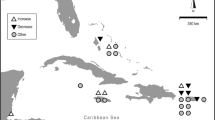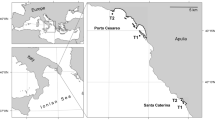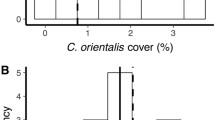Abstract
This study tested the hypothesis that sponge assemblages on the reefs of St. John, US Virgin Islands (18.315°N, 64.716°W), changed from 1992 to 2017. Sponges were identified to species or genus in photoquadrats and were quantified at 2–3 y intervals by density, with linear dimensions used to estimate volume as a proxy for biomass. From 1992 to July 2017, overall sponge density (pooled among taxa) increased, although trends varied among the most common species for which density increased (four species), decreased (one species), or showed no linear relationship with time (2 species). Hurricanes Irma and Maria caused a 51% decline in overall sponge density from July to November 2017, with density in November 2017 being 31% lower than in 1992. For the common sponges, densities of 6 declined by 82–100% between July and November 2017, but densities in November 2017 were 13–736% higher than in 1992 for four species, and 47–100% lower than in 1992 for 3 species. Sponge volume did not change linearly between 1992 and November 2017, but it was reduced by 54% following the hurricanes. Multivariate variation over time in benthic community structure was not strongly associated with sponge density alone, although a significant association with rainfall highlighted the potential roles of this environmental factor in directly, or indirectly, mediating changes in community structure. Overall, the mean density of sponges, as well as most of the common sponge species, trended upwards prior to the hurricanes, but these trends reversed following the storms.






Similar content being viewed by others
Data accessibility
The data for this project are hosted at: https://doi.org/10.26008/1912/bco-dmo.819397.1, https://doi.org/10.26008/1912/bco-dmo.819463.1, https://doi.org/10.26008/1912/bco-dmo.819471.1, https://doi.org/10.26008/1912/bco-dmo.819479.1.
References
Abràmoff MD, Magalhães PJ, Ram SJ (2004) Image processing with Image J. Biophotonics Int 11:36–42
Alvarez-Filip L, Côté IM, Gill JA, Watkinson AR, Dulvy NK (2011) Region-wide temporal and spatial variation in Caribbean reef architecture: is coral cover the whole story? Glob Chang Biol 17:2470–2477. https://doi.org/10.1111/j.1365-2486.2010.02385.x
Aronson RB, Precht WF, Macintyre IG, Toth LT (2012) Catastrophe and the life span of coral reefs. Ecology 93:303–313. https://doi.org/10.1890/11-1037.1
Beijbom O, Edmunds PJ, Roelfsema C, Smith J, Kline DI, Neal BP, Dunlap MJ, Moriarty V, Fan T-Y, Tan C-J, Chan S, Treibitz T, Gamst A, Mitchell BG, Kriegman D (2015) Towards automated annotation of benthic survey images: variability of human experts and operational modes of automation. PLoS ONE 10:e0130312. https://doi.org/10.1371/journal.pone.0130312
Bell J (2008) Functional roles of sponges. Estuar Coast Shelf Sci 79:341–353. https://doi.org/10.1016/j.ecss.2008.05.002
Bell JJ, Davy SK, Jones T, Taylor MW, Webster NS (2013) Could some coral reefs become sponge reefs as our climate changes? Glob Chang Biol 19:2613–2624. https://doi.org/10.1111/gcb.12212
Bellwood DR, Hughes TP, Folke C, Nyström M (2004) Confronting the coral reef crisis. Nature 429:827–833. https://doi.org/10.1038/nature02691
Braverman I (2018) Coral whisperers scientists on the brink. University of California Press, Oakland
Bruno JF, Sweatman H, Precht WF, Selig ER, Schutte VGW (2009) Assessing evidence of phase shifts from coral to macroalgal dominance on coral reefs. Ecology 90:1478–1484. https://doi.org/10.1890/08-1781.1
Butler MJ IV, Hunt JH, Herrnkind WF, Childress MJ, Bertelsen R, Sharp W, Matthews T, Field JM, Marshall HG (1995) Cascading disturbances in Florida Bay, USA: cyanobacteria blooms, sponge mortality, and implications for juvenile spiny lobsters Panulirus argus. Mar Ecol Prog Ser 129:119–125. https://doi.org/10.3354/meps129119
Clarke KR, Gorley RN (2006) PRIMER V6: User Manual/tutorial. PRIMER-E, Plymouth
Colvard NB, Edmunds PJ (2011) Decadal-scale changes in abundance of non-scleractinian invertebrates on a Caribbean coral reef. J Exp Mar Bio Ecol 397:153–160. https://doi.org/10.1016/j.jembe.2010.11.015
Cowart JD, Henkel TP, McMurray SE, Pawlik JR (2006) Sponge orange band (SOB): a pathogenic-like condition of the giant barrel sponge, Xestospongia muta. Coral Reefs 25:513. https://doi.org/10.1007/s00338-006-0149-y
Connell JH (1978) Diversity in tropical rain forests and coral reefs. Science 199:1302–1310. https://doi.org/10.1126/science.199.4335.1302
Cramer KL, Jackson JBC, Angioletti CV, Leonard-Pingel J, Guilderson TP (2012) Anthropogenic mortality on coral reefs in Caribbean Panama predates coral disease and bleaching. Ecol Lett 15:561–567. https://doi.org/10.1111/j.1461-0248.2012.01768.x
de Bakker DM, van Duyl FC, Bak RPM, Nugues MM, Nieuwland G, Meesters EH (2017) 40 Years of benthic community change on the Caribbean reefs of Curaçao and Bonaire: the rise of slimy cyanobacterial mats. Coral Reefs 36:355–367. https://doi.org/10.1007/s00338-016-1534-9
Diaz CM, Rützler K (2001) Sponges: an essential component of Caribbean coral reefs. Bull Mar Sci 69:535–546
Easson CG, Slattery M, Momm HG, Olson JB, Thacker RW, Gochfeld DJ (2013) Exploring individual- to population-level impacts of disease on coral reef sponges: using spatial analysis to assess the fate, dynamics, and transmission of Aplysina Red Band Syndrome (ARBS). PlosONE 8:e79976
Edmunds PJ (2000) Patterns in the distribution of juvenile corals and coral reef community structure in St. John, US Virgin Islands. Mar Ecol Prog Ser 202:113–124. https://doi.org/10.3354/meps202113
Edmunds PJ (2013) Decadal-scale changes in the community structure of coral reefs of St. John, US Virgin Islands. Mar Ecol Prog Ser 489:107–123. https://doi.org/10.3354/meps10424
Edmunds PJ (2018) The hidden dynamics of low coral cover communities. Hydrobiologia 818:193–209. https://doi.org/10.1007/s10750-018-3609-9
Edmunds PJ (2019) Three decades of degradation lead to diminished impacts of severe hurricanes on Caribbean reefs. Ecology 100:e02587. https://doi.org/10.1002/ecy.2587
Edmunds PJ, Gray SC (2014) The effects of storms, heavy rain, and sedimentation on the shallow coral reefs of St. John, US Virgin Islands. Hydrobiologia 734:143–158. https://doi.org/10.1007/s10750-014-1876-7
Edmunds PJ, Lasker HR (2016) Cryptic regime shift in benthic community structure on shallow reefs in St. John, US Virgin Islands. Mar Ecol Prog Ser 559:1–12. https://doi.org/10.3354/meps11900
Fabricius KE (2005) Effects of terrestrial runoff on the ecology of corals and coral reefs: review and synthesis. Mar Pollut Bull 50:125–146. https://doi.org/10.1016/j.marpolbul.2004.11.028
Gardner TA, Cote IM, Gill JA, Grant A, Watkinson AR (2005) Hurricanes and Caribbean coral reefs: impacts, recovery patterns, and role in long-term decline. Ecology 86:174–184
Glasl B, Webster NS, Bourne DG (2017) Microbial indicators as a diagnostic tool for assessing water quality and climate stress in coral reef ecosystems. Mar Biol 164:91. https://doi.org/10.1007/s00227-017-3097-x
Gochfeld DJ, Olson JB, Chaves-Fonnegra A, Smith TB, Ennis RS, Brandt ME (2020) Impacts of Hurricanes Irma and Maria on coral reef sponge communities in St Thomas, US Virgin Islands. Estuaries Coasts. https://doi.org/10.1007/s12237-020-00694-4
Goreau TF (1959) The ecology of Jamaican coral reefs I. species composition and zonation. Ecology 40:67–90. https://doi.org/10.2307/1929924
Gross K, Edmunds PJ (2015) Stability of Caribbean coral communities quantified by long-term monitoring and autoregression models. Ecology 96:1812–1822. https://doi.org/10.1890/14-0941.1
Guest JR, Edmunds PJ, Gates RD, Kuffner IB, Andersson AJ, Barnes BB, Chollett I, Courtney TA, Elahi R, Gross K, Lenz EA, Mitarai S, Mumby PJ, Nelson HR, Parker BA, Putnam HM, Rogers CS, Toth LT (2018) A framework for identifying and characterising coral reef "oases" against a backdrop of degradation. J Appl Ecol 55:2865–2875. https://doi.org/10.1111/1365-2664.13179
Harris RMB, Beaumont LJ, Vance TR, Tozer CR, Remenyi TA, Perkins-Kirkpatrick SE, Mitchell PJ, Nicotra AB, McGregor S, Andrew NR, Letnic M, Kearney MR, Wernberg T, Hutley LB, Chambers LE, Fletcher M-S, Keatley MR, Woodward CA, Williamson G, Duke NC, Bowman DMJS (2018) Biological responses to the press and pulse of climate trends and extreme events. Nat Clim Chang 8:579–587. https://doi.org/10.1038/s41558-018-0187-9
Hoegh-Guldberg O, Mumby PJ, Hooten AJ, Steneck RS, Greenfield P, Gomez E, Harvell CD, Sale PF, Edwards AJ, Caldeira K, Knowlton N, Eakin CM, Iglesias-Prieto R, Muthiga N, Bradbury RH, Dubi A, Hatziolos ME (2007) Coral reefs under rapid climate change and ocean acidification. Science 318:1737–1742. https://doi.org/10.1126/science.1152509
Hughes TP, Graham NAJ, Jackson JBC, Mumby PJ, Steneck RS (2010) Rising to the challenge of sustaining coral reef resilience. Trends Ecol Evol 25:633–642. https://doi.org/10.1016/j.tree.2010.07.011
Hughes TP, Kerry JT, Álvarez-Noriega M, Álvarez-Romero JG, Anderson KD, Baird AH, Babcock RC, Beger M, Bellwood DR, Berkelmans R, Bridge TC, Butler IR, Byrne M, Cantin NE, Comeau S, Connolly SR, Cumming GS, Dalton SJ, Diaz-Pulido G, Eakin CM, Figueira WF, Gilmour JP, Harrison HB, Heron SF, Hoey AS, Hobbs J-PA, Hoogenboom MO, Kennedy EV, Kuo C, Lough JM, Lowe RJ, Liu G, McCulloch MT, Malcolm HA, McWilliam MJ, Pandolfi JM, Pears RJ, Pratchett MS, Schoepf V, Simpson T, Skirving WJ, Sommer B, Torda G, Wachenfeld DR, Willis BL, Wilson SK (2017) Global warming and recurrent mass bleaching of corals. Nature 543:373–377. https://doi.org/10.1038/nature21707
Huston MA (1985) Patterns of species diversity on coral reefs. Annu Rev Ecol Syst 16:149–177. https://doi.org/10.1146/annurev.es.16.110185.001053
Jackson JBC (1997) Reefs since Columbus. Coral Reefs 16:S23–S32. https://doi.org/10.1007/s003380050238
Jackson JBC, Donovan MK, Cramer KL, Lam VV (eds) (2014) Status and trends of Caribbean coral reefs: 1970–2012. Global coral reef monitoring network. IUCN, Gland
Jackson ST (2007) Looking forward from the past: history, ecology, and conservation. Front Ecol Environ 5:455. https://doi.org/10.1890/1540-9295(2007)5[455:LFFTPH]2.0.CO;2
Jones CG, Lawton JH, Shachak M (1994) Organisms as ecosystem engineers. Oikos 69:373–386. https://doi.org/10.2307/3545850
Kajtar JB, Collins M, Frankcombe LM, England MH, Osborn TJ, Juniper M (2019) Global mean surface temperature response to large-scale patterns of variability in observations and CMIP5. Geophys Res Lett 46:2232–2241. https://doi.org/10.1029/2018GL081462
Kohler KE, Gill SM (2006) Coral Point Count with Excel extensions (CPCe): A Visual Basic program for the determination of coral and substrate coverage using random point count methodology. Comput Geosci 32:1259–1269. https://doi.org/10.1016/j.cageo.2005.11.009
Lenz EA, Bramanti L, Lasker HR, Edmunds PJ (2015) Long-term variation of octocoral populations in St. John, US Virgin Islands. Coral Reefs 34:1099–1109. https://doi.org/10.1007/s00338-015-1315-x
Lessios HA (2016) The great Diadema antillarum die-off: 30 years later. Ann Rev Mar Sci 8:267–283. https://doi.org/10.1146/annurev-marine-122414-033857
Loya Y (1972) Community structure and species diversity of hermatypic corals at Eilat, Red Sea. Mar Biol 13:100–123. https://doi.org/10.1007/BF00366561
Maliao RJ, Turingan RG, Lin J (2008) Phase-shift in coral reef communities in the Florida Keys National Marine Sanctuary (FKNMS), USA. Mar Biol 154:841–853. https://doi.org/10.1007/s00227-008-0977-0
McClenachan L, O’Connor G, Neal BP, Pandolfi JM, Jackson JBC (2017) Ghost reefs: nautical charts document large spatial scale of coral reef loss over 240 years. Sci Adv 3:e1603155. https://doi.org/10.1126/sciadv.1603155
McCook LJ, Jompa J, Diaz-Pulido G (2001) Competition between corals and algae on coral reefs: a review of evidence and mechanisms. Coral Reefs 19:400–417. https://doi.org/10.1007/s003380000129
McMurray SE, Henkel TP, Pawlik JR (2010) Demographics of increasing populations of the giant barrel sponge Xestospongia muta in the Florida Keys. Ecology 91:560–570. https://doi.org/10.1890/08-2060.1
Moran PJ (1986) The Acanthaster phenomenon. Oceanogr Mar BioI Ann Rev 24:379–480
Olinger LK, Scott AR, McMurray SE, Pawlik JR (2019) Growth estimates of Caribbean reef sponges on a shipwreck using 3D photogrammetry. Sci Rep 9:8398. https://doi.org/10.1038/s41598-019-54681-2
Pandolfi JM (2015) Incorporating uncertainty in predicting the future response of coral reefs to climate change. Annu Rev Ecol Evol Syst 46:281–303. https://doi.org/10.1146/annurev-ecolsys-120213-091811
Pandolfi JM, Jackson JBC, Baron N, Bradbury RH, Guzman HM, Hughes TP, Kappel CV, Micheli F, Ogden JC, Possingham HP, Sala E (2005) Are U.S. coral reefs on the slippery slope to slime? Science 307:1725–1726. https://doi.org/10.1126/science.1104258
Pawlik JR, McMurray SE (2020) The emerging ecological and biogeochemical importance of sponges on coral reefs. Ann Rev Mar Sci 12:315–337. https://doi.org/10.1146/annurev-marine-010419-010807
Precht WF, Miller SL (2007) Ecological shifts along the Florida Reef tract: the past as a key to the future. In: Aronson RB (ed) Geological approaches to coral reef ecology, 1st edn. Springer, New York, pp 237–312
Ramsby BD, Hoogenboom MO, Whalen S, Webster NS, Thompson A (2017) A decadal analysis of bioeroding sponge cover on the inshore Great Barrier Reef. Sci Rep 7:2706
Reiswig HM (1971a) In situ pumping activities of tropical Demospongiae. Mar Biol 9:38–50. https://doi.org/10.1007/BF00348816
Reiswig HM (1971b) Particle feeding in natural populations of three marine demosponges. Biol Bull 141:568–591. https://doi.org/10.2307/1540270
Reiswig HM (1972) The spectrum of particulate organic matter of shallow-bottom boundary waters of Jamaica. Limnol Oceanogr 17:341–348. https://doi.org/10.4319/lo.1972.17.3.0341
Reiswig HM (1973) Population dynamics of three Jamaican Demospongiae. Bull Mar Sci 23:191–226
Rogers CS, Miller J, Muller EM, Edmunds P, Nemeth RS, Beets JP, Friedlander AM, Smith TB, Boulon R, Jeffrey CFG, Menza C, Caldow C, Idrisi N, Kojis B, Monaco ME, Spitzack A, Gladfelter EH, Ogden JC, Hillis-Starr Z, Lundgren I, Bane Schill W, Kuffner IB, Richardson LL, Devine BE, Voss JD (2008) Ecology of coral reefs in the US Virgin Islands. In: Riegl BM, Dodge RE (eds) Coral reefs of the USA, 1st edn. Springer, Dordrecht, pp 303–373
Rovellini A, Dunn MR, Fulton EA, Webster NS, Smith DJ, Jompa J, Haris A, Berman J, Bell JJ (2019) Decadal variability in sponge abundance and biodiversity on an Indo-Pacific coral reef. Mar Ecol Prog Ser 620:63–76
Ruzicka RR, Colella MA, Porter JW, Morrison JM, Kidney JA, Brinkhuis V, Lunz KS, Macaulay KA, Bartlett LA, Meyers MK, Colee J (2013) Temporal changes in benthic assemblages on Florida Keys reefs 11 years after the 1997/1998 El Niño. Mar Ecol Prog Ser 489:125–141. https://doi.org/10.3354/meps10427
Rützler K (1978) Sponges in coral reefs. In: Stoddart DR, Johannes RE (eds) Coral reefs: research methods: monographs on oceanographic methodology 5. UNESCO, Paris, pp 299–313
Stevely JM, Sweat DE, Bert TM, Sim-Smith C, Kelly M (2011) Sponge mortality at Marathon and Long Key, Florida: patterns of species response and population recovery. Proc 63rd Gulf Caribb Fish Inst 63:384–400
Tsounis G, Edmunds PJ (2017) Three decades of coral reef community dynamics in St. John USVI: a contrast of scleractinians and octocorals. Ecosphere 8:e01646. https://doi.org/10.1002/ecs2.1646
Tsounis G, Edmunds PJ, Bramanti L, Gambrel B, Lasker HR (2018) Variability of size structure and species composition in Caribbean octocoral communities under contrasting environmental conditions. Mar Biol 165:29. https://doi.org/10.1007/s00227-018-3286-2
Turner MG, Dale VH, Everham EH III (1997) Fires, hurricanes, and volcanoes: comparing large disturbances. Bioscience 47:758–768. https://doi.org/10.2307/1313098
van Soest RWM, Boury-Esnault N, Vacelet J, Dohrmann M, de Erpenbeck Voogd N, Santodomingo N, Vanhoome B, Kelly M, Hooper JNA (2012) Global diversity of sponges (Porifera). PLoS ONE 7:e35105
Veron JEN, Hoegh-Guldberg O, Lenton TM, Lough JM, Obura DO, Pearce-Kelly P, Sheppard CRC, Spalding M, Stafford-Smith MG, Rogers AD (2009) The coral reef crisis: the critical importance of <350 ppm CO2. Mar Pollut Bull 58:1428–1436. https://doi.org/10.1016/j.marpolbul.2009.09.009
Villamizar E, Diaz MC, Rützler K, De Nobrega R (2014) Biodiversity, ecological structure, and change in the sponge community of different geomorphological zones of the barrier fore reef at Carrie Bow Cay, Belize. Mar Ecol 35:425–435
Ward-Paige CA, Risk MJ, Sherwood OA, Jaap WC (2005) Clionid sponge surveys on the Florida Reef Tract suggest land-based nutrient inputs. Mar Pollut Bull 51:570–579. https://doi.org/10.1016/j.marpolbul.2005.04.006
Webster NS (2007) Sponge disease: a global threat? Environ Microbiol 9:1363–1375. https://doi.org/10.1111/j.1462-2920.2007.01303.x
Wild C, Hoegh-Guldberg O, Naumann MS, Colombo-Pallotta MF, Ateweberhan M, Fitt WK, Iglesias-Prieto R, Palmer C, Bythell JC, Ortiz J-C, Loya Y, van Woesik R (2011) Climate change impedes scleractinian corals as primary reef ecosystem engineers. Mar Freshw Res 62:205–215. https://doi.org/10.1071/MF10254
Woodley JD, Chornesky EA, Clifford PA, Jackson JBC, Kaufman LS, Knowlton N, Lang JC, Pearson MP, Porter JW, Rooney MC, Rylaarsdam KW, Tunnicliffe VJ, Wahle CM, Wulff JL, Curtis ASG, Dallmeyer MD, Jupp BP, Koehl MAR, Neigel J, Sides EM (1981) Hurricane Allen’s impact on Jamaican coral reefs. Science 214:749–755. https://doi.org/10.1126/science.214.4522.749
Wulff JL (1984) Sponge-mediated coral reef growth and rejuvenation. Coral Reefs 3:157–163. https://doi.org/10.1007/bf00301960
Wulff JL (1991) Asexual fragmentation, genotype success, and population dynamics of erect branching sponges. J Exp Mar Biol Ecol 149:227–247
Wulff JL (1995) Effects of a hurricane on survival and orientation of large erect coral reef sponges. Coral Reefs 14:55–61. https://doi.org/10.1007/BF00304073
Wulff JL (2001) Assessing and monitoring coral reef sponges: why and how? Bull Mar Sci 69:831–846
Wulff JL (2006a) Rapid diversity and abundance decline in a Caribbean coral reef sponge community. Biol Conserv 127:167–176. https://doi.org/10.1016/j.biocon.2005.08.007
Wulff JL (2006b) Resistance vs recovery: morphological strategies of coral reef sponges. Funct Ecol 20:699–708. https://doi.org/10.1111/j.1365-2435.2006.01143.x
Wulff JL (2006c) A simple model of growth form-dependent recovery from disease in coral reef sponges, and implications for monitoring. Coral Reefs 25:419–426. https://doi.org/10.1007/s00338-006-0110-0
Wulff JL (2009) Sponge community dynamics on Caribbean mangrove roots: significance of species idiosyncrasies. In: Lang MA, Macintyre IG, Rützler K (eds) Smithsonian contributions to marine science 38. Smithsonian Institution, Washington, DC, pp 501–514
Wulff J (2013) Recovery of sponges after extreme mortality events: morphological and taxonomic patterns in regeneration versus recruitment. Integr Comp Biol 53:512–523. https://doi.org/10.1093/icb/ict059
Wulff J (2016) Sponge contributions to the geology and biology of reefs: past, present, and future. In: Hubbard DK, Rogers CS, Lipps JH, Stanley GD (eds) Coral reefs at the crossroads, 6th edn. Springer, Dordrecht, pp 103–126
Wulff JL, Buss LW (1979) Do sponges help hold coral reefs together? Nature 281:474–475. https://doi.org/10.1038/281474a0
Acknowledgements
The fieldwork was completed with the assistance of many people between 1992 and 2017, and to all we are grateful. PJE thanks B Steinman and J Kajtar for generous assistance in interpreting the AMO index. Comments from two reviewers improved an earlier draft of this paper. This is contribution number 311 of the CSUN marine biology program.
Author information
Authors and Affiliations
Corresponding author
Ethics declarations
Conflict of interests
All applicable international, national, and/or institutional guidelines for the care and use of animals were followed (no animals were manipulated or sampled in this research). Research was completed under research permits issued through the Virgin Islands National Park over decades (in 2018: VIIS-2018-SCI-0012). This research was funding by the US National Science Foundation (DEB 13–50146 and OCE 17–56678), and included an REU award to M. Coblentz. The authors have no conflict of interests.
Additional information
Communicated by D. Gochfeld.
Publisher's Note
Springer Nature remains neutral with regard to jurisdictional claims in published maps and institutional affiliations.
Electronic supplementary material
Below is the link to the electronic supplementary material.
Rights and permissions
About this article
Cite this article
Edmunds, P.J., Coblentz, M. & Wulff, J. A quarter-century of variation in sponge abundance and community structure on shallow reefs in St. John, US Virgin Islands. Mar Biol 167, 135 (2020). https://doi.org/10.1007/s00227-020-03740-8
Received:
Accepted:
Published:
DOI: https://doi.org/10.1007/s00227-020-03740-8




